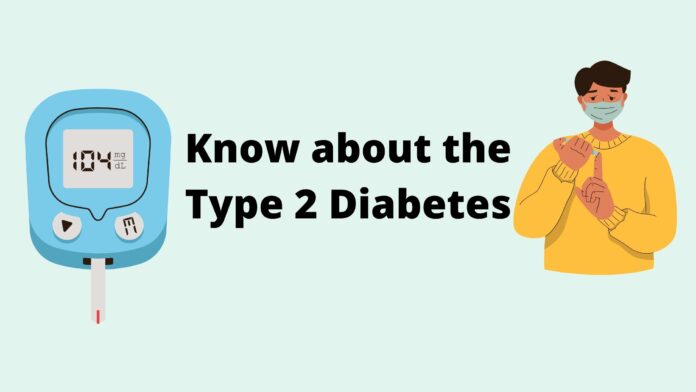What is Diabetes?
Diabetes is a pathological condition of the human body that occurs due to an increase in blood sugar (glucose) levels, also known as hyperglycemia, which is caused due to defects in insulin production or action or both. It is a disorder that causes a chronic rise in glucose levels in the blood. Diabetes can cause long-term dysfunction and even failure of various organs like the kidneys, heart, eyes, nerves, and blood vessels. The damage can be at a microscopic or macroscopic level.
Diabetes can be broadly classified into:
- Type 1 Diabetes Mellitus
- Type 2 Diabetes Mellitus
- Gestational Diabetes
- Others:
– Maturity Onset Diabetes Mellitus
– LADA
– Endocrinopathies
Type 2 Diabetes or T2DM is characterised by the resistance of insulin hormone or the defective/slow response of the hormone after food intake. The most common form of diabetes is Type 2 Diabetes. It comprises 90% of people who have diabetes. Insulin is a regulatory hormone produced by the pancreas. It controls the high blood glucose levels whenever there is a spike, especially after food intake, and brings it back to the normal limit.
Signs and Symptoms
Signs and symptoms of T2DM develop slowly. One can have type 2 diabetes for years without their knowledge. These are as follows:
- Polyuria (an increase in the frequency of urination)
- Polyphagia (an increase in hunger)
- Polydipsia (an increase in thirst)
- Fatigue
- Blurring of vision
- Increased time of wound healing
- Frequent infections
- Tingling or numbing sensation in the limbs
- Acanthosis Nigricans (darkening of skin folds, e.g., armpits, neck, etc.)
When to visit a doctor?
Whenever any signs or symptoms or a combination of a few are seen, one has to see the doctor immediately to start the treatment of Type 2 Diabetes as soon as possible.
Probable causes of Type 2 Diabetes
- Due to insulin resistance, cells in the liver, muscle, and fat do not interact properly and, therefore, cannot utilise enough sugar.
- The insulin produced by the pancreas cannot initiate the necessary actions required to manage sugar levels in the blood.
Being inactive and overweight can also cause Type 2 Diabetes.
Risk factors
- Being overweight or obese is the main risk
- Truncal obesity
- Less active lifestyle
- Positive family history
- High blood lipid levels
- Age (more in older age groups >45 years)
- Prediabetic
- Gestational Diabetes
- Polycystic ovary syndrome
- Acanthosis Nigricans
Complications
For a long time, Diabetesmellitus Type 2 has affected major organs like blood vessels, heart, nerves, kidneys, eyes, etc. Proper monitoring and control of blood sugar reduce the risk of these associated abnormalities and pathological conditions. Following are the organs which might be affected if sugar levels in the blood go beyond control.
- Cardiovascular disease is associated with an increased risk of atherosclerosis, heart disease, and hypertension.
- Kidney disease: It may lead to chronic kidney disease or irreversible end-stage kidney disease that might require dialysis or a kidney transplant.
- Neuropathy: High blood sugar levels for long durations can damage the nerves, resulting in numbness, tingling, burning, pain, or loss of feeling that begins at the toes and tips of fingers and spreads upward.
- Other nerve damages: Damage to nerves connecting the heart can asynchronize heartbeats. If nerves in the gut region are damaged, nausea, vomiting, diarrhoea, or constipation can occur. For men, erectile dysfunction may occur due to such damage.
- Skin conditions: People with Type 2 Diabetes are more susceptible to skin diseases, like bacterial and fungal infections with slow healing.
- Eye damage: People with Type 2 Diabetes are also susceptible to glaucoma, cataracts, and damage to the retinal blood vessels, which can cause blindness.
- Slow healing: Untreated cuts and wounds can turn into serious infections with poor healing. Severe damage can also lead to amputation of the affected finger or limb.
- Sleep apnea. Obesity may contribute to obstructive sleep apnea, though the role of T2DM is not known.
- Hearing impairment
- Dementia. Unregulated blood sugar levels can lead to a rapid decline in memory and other cognitive skills. It can also increase the risk of Alzheimer’s disease.
How To Prevent Diabetes?
Want to know how to prevent diabetes? A healthy change in lifestyle can help prevent Diabetes mellitus, even if the family history is positive. If prediabetic, such changes can slow down the development of Type 2 Diabetes.
Some tips for following a healthy lifestyle include:
- Intake of healthy food- Foods with lower fat and calorie content and high fibre are best for people with T2DM. Increasing the intake of fresh fruits, green vegetables, and whole grains and avoiding junk, oily, or spicy food.
- Exercising and remaining active- One must schedule 2-3 hours per week for moderate to vigorous activity, which can include brisk walking, running, bicycling, yoga, and swimming.
- Losing weight – Losing a calculated amount of weight as advised by a physician and maintaining it can delay the progression from prediabetic to full-blown Diabetes mellitus. Losing 7%-10% of body weight can reduce the risk of developing T2DM.
- Remaining Inactive for long durations- Sitting for long periods without doing any active work can increase the risk of Diabetes mellitus. Efforts should be made to get up every 30 minutes and move for some time at regular intervals.
Medications like metformin (Fortamet, Glumetza), an oral hypoglycemic agent (OHA), can be prescribed for prediabetic people to reduce the risk of development of Type 2 Diabetes. This is usually applicable for the elderly who are obese and are unable to lower blood sugar levels with lifestyle changes only.
Write and Win: Participate in Creative writing Contest & International Essay Contest and win fabulous prizes.
















